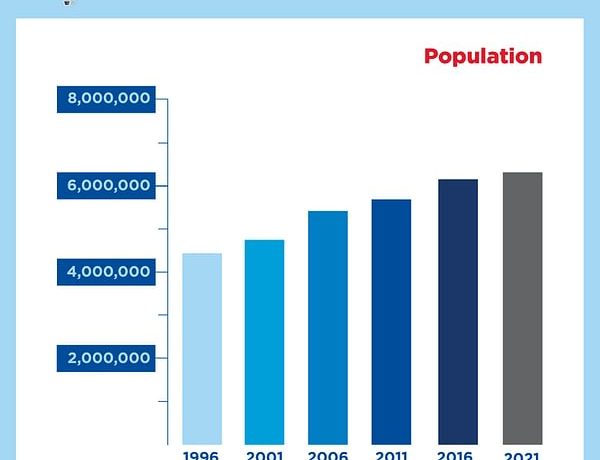This content has been archived. It may no longer be relevant
RE/MAX Canada analyzed population trends and their impact on the GTA real estate market over the last 25 years. Spoiler alert: the rapid rise of people who call the Greater Toronto Area (GTA) “home” is just one factor that’s putting immense pressure on the local housing market. You can read about the other “pressure points” in RE/MAX Canada’s new Greater Toronto Area (GTA) Quarter Century Market Report. For now, let’s focus on population.
Demand Drives GTA Real Estate Sales & Price Growth
The GTA’s population has exploded over the past 25 years, rising by approximately 2,000,000 people — a 45-per-cent increase over the 1996 Census, from 4,263,759 to 6,202,225 per the latest 2021 Census figure. This figure actually fell about 300,000 short of Statistics Canada’s 2021 population estimate for the Toronto CMA, reflecting the substantial slowdown in immigration activity at the height of the pandemic in 2020 and 2021.
As the population grew, so too did demand for housing, with more than 2,000,000 homes changing hands in the GTA real estate market over the 25-year period, doubling 1996 levels in 2021. As demand for housing continues to climb, and the GTA population expected to further soar, supply constraints are increasingly evident. Canada will welcome more than 1.2 million newcomers over the next three years and, given current demographic realities, this is likely to continue in the years ahead.
Demographics have changed, too. The number of one-person private households in the Toronto CMA have yet to be made available for 2021, but the 2016 Census saw a marked increase of 10.4 per cent over the previous 2011 figure (519,795 versus 470,615). That number is likely to climb again in the 2021 Census. Likely contributors to the shift are an aging population (as Baby Boomers move through the cycle); rising divorce rates (2.74 million Canadians were divorced in Canada in 2021, up from 2.07 million per cent in 2004) and an uptick in international students likely contributed to the increase in one-person private households.
Now add a housing supply shortage into the mix, and it’s a recipe for rising prices.
Tight GTA Real Estate Market is About to Get Even Tighter
“Immigration into Canada and the GTA is expected to be at or near record levels in 2022. All of these people will require a place to live. On top of this, job creation in average to above-average income sectors is expected to remain strong, further buoying consumer confidence to make a large-ticket purchase of a home. Unfortunately, the supply of listings will remain constrained, sustaining strong competition between buyers and double-digit growth in selling prices,” said Toronto Regional Real Estate Board President Kevin Crigger in the board’s January market report and 2022 outlook.
If you’re wondering what that trajectory might look like for GTA real estate, consider these trend lines over the last 25 years:
Looking ahead, RE/MAX Canada’s estimated price outlook for Toronto real estate in 2022 is an increase of 10 per cent to $1,160,491.
GTA Population On Track to 10 Million by Mid-2040?
A coming population surge projects Greater Toronto to be Ontario’s fastest-growing region, increasing to more than 10.2 million by 2046, according to a Ministry of Finance report. The same report expects the GTA’s share of the provincial population to rise to 51.8 per cent in 2046 from 47.8 per cent in 2018. Migration (immigrants and other Canadians drawn to the Greater Toronto Area) will account for around 82 per cent of the province’s growth.
Urbanization is, of course, a global trend. The most recent data from the United Nations says the number of the world’s megacities — cities with more than 10 million inhabitants — is projected to rise to 43 in 2030, up from 33 in 2018. But well before Greater Toronto enters into the 10-million club, we will hit a demographic turning point in 2033, with half of all Ontarians living in the GTA for the first time.
Toronto, The Good
There’s a reason that Knight Frank ranked Toronto sixth on their Health, Wealth and Innovation Index in 2021. Toronto also ranked 17th in their Urban Leaders chart, the only Canadian market to make the Knight Frank City Wealth Index.
Canada’s financial centre remains a magnet for new immigrants who seek government stability, quality of life, safety and security, world-class education, a stable banking system and a health-care system that is the envy of the world.
A Boston Consulting Group study ranked Canada as the top destination for global talent in 2020, with Canada moving ahead of the US – based on a survey of 200,000 international job seekers from 197 countries.
All this to say, Toronto is a top destination and a world-class city, by all standards.
…And Housing For All
To ensure continued growth, our federal, provincial and municipal governments must take the right steps to ensure affordable housing for all.
With pressure mounting and prices rising, the Ontario government established a Housing Affordability Task Force, who recently tabled a number of supply-based solutions to the province’s housing crisis — since government-implemented policies and taxes of the past have not had a sustained cooling impact on the housing market.
The 55 recommendations aim to reach an “achievable goal” of 1.5 million new homes in the next 10 years, including:
- Increase housing density across the province
- End exclusionary municipal rules that block or delay new housing
- Depoliticize the housing approvals process
- Prevent abuse of the housing appeals system
- Provide financial support to municipalities that build more housing
With rising residential prices far outpacing incomes, and not enough homes on the market for the existing population, let alone the flood to come, the housing affordability issue is bound to intensify.
The post GTA Real Estate Hit by Quarter-Century Population Swell appeared first on RE/MAX Canada.




